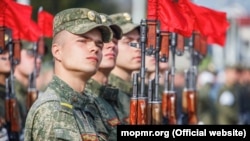On September 23, Russia’s TASS state news agency reported that Vadim Krasnoselsky, leader of Transnistria, the unrecognized separatist republic inside Moldova, backed the presence of Russian troops as “peacekeepers” in the territory.
According to TASS, Krasnoselsky made his comment during a meeting with Konstantin Kosachev, deputy speaker of the Federation Council (Russia’s upper house of parliament). TASS quoted Krasnoselsky’s press service as saying:
"The positive role of the peacekeeping operation on the Dniester was emphasized as well as the lack of an alternative to the existing format of the mission until the Transnistrian Moldovan Republic and the Republic of Moldova finally settle their relations."
The TASS piece added:
“Russian peacekeepers were brought into the conflict zone on July 29, 1992, under the Agreement on the Principles for a Peaceful Settlement of the Armed Conflict in the Dniester Region of the Republic of Moldova. The agreement was signed on July 21, 1992, by the Russian and Moldovan presidents in the presence of the Transnistrian leader.”
Both of those claims are highly misleading.
Although some Russians are serving as peacekeepers in Transnistria under the aegis of the Joint Control Commission, they are only a small portion of the estimated 1,400 Russian troops overall.
And there is missing context.
Moldovan President Maia Sandu, in a speech to the United Nations General Assembly the day before Krasnoselsky met with Kosachev, reiterated her call for Russian troops to leave Transnistria. She also called for liquidation of the Soviet-era arms depot at Cobasna in northern Transnistria.
Sandu first called for the removal of Russian forces from Transnistria in December 2020, the same month she took office. Then, as now, Russian officials met her call with obfuscation.
Russian Foreign Minister Sergey Lavrov argued that the Russian troops in Transnistria were mostly guarding the arms depot, and that a pullout would leave that site unsecured. Polygraph previously fact-checked that claim and similar ones and found them misleading.
The Russian troops that are not operating under the authority of the Joint Control Commission are not neutral peacekeepers and are accused of propping up the separatist state and its military. They have held joint military exercises with the Transnistrian armed forces.
It was the intervention of Russian troops in 1992 that secured Transnistria’s de facto autonomy from Moldova. Since then, the United Nations and the Organization for Security and Cooperation in Europe (OSCE) have repeatedly called for Russia unconditionally to remove its troops from Moldovan territory.
Russia and the OSCE signed an agreement in Istanbul in 1999 that set a deadline for Russian troops to leave by 2002. Nothing has budged.
As for the security of the arms depot at Cobasna?
Transnistria’s role in the global illicit arms trade has been documented. Viktor Bout, the currently-imprisoned arms dealer once known as the “Merchant of Death,” used to operate in Transnistria.
Maia Sandu has made a counterproposal on peacekeeping in Transnistria – that the armed Russian troops be replaced by a civilian monitoring mission under the auspices of the OSCE.





